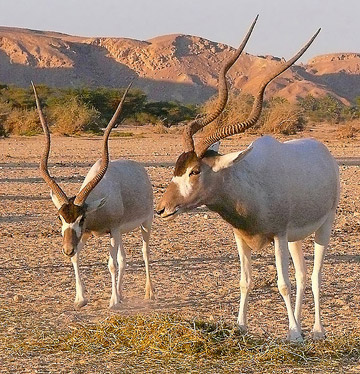How Many Species Of Animals Are There In The Sahara Desert
Bigger than all of Brazil, amidst the harshest ecosystems on Earth, and largely undeveloped, 1 would await that the Sahara desert would exist a oasis for desert wild fauna. One would conceptualize that large African animals—which are facing poaching and habitat loss in other parts of the globe—would thrive in this vast wilderness. Only a new landmark study in Diversity and Distributions finds that the megafauna of the Sahara desert are on the verge of total plummet.
"While global attention has been focused on [biodiversity] hotspots, the world's largest tropical desert, the Sahara, has suffered a catastrophic decline in megafauna," the researchers write.
Looking at xiv large-bodied animals, the written report institute that 86 per centum of them (ten of the species) were either extinct or endangered. Four of them (28 pct) are already extinct in the region. The Bubal hartebeest (Alcelaphus buselaphus buselaphus) is gone forever while the scimitar-horned oryx (Oryx dammah) is extinct in the wild, although there are efforts to re-introduce information technology. Meanwhile, two of the Sahara's once meridian predators are gone: the African wild dog (Lycaon pictus) and the African lion (Lion).

Herd of wild addax in Termit and Tin Toumma National Nature Reserve in Niger. Photo by: Copyright Thomas Rabeil and Sahara Conservation Fund.
Megafauna that are still around aren't doing much better. The dama gazelle (Nanger dama), the addax (Addax nasomaculatus), and the Saharan cheetah (Acinonyx jubatus hecki) are all on the razor-edge of extinction with each one listed equally Critically Endangered by the IUCN Red List. The dama gazelle and the addax are absent-minded from 99 pct of their celebrated range; less than 500 dama gazelles survive, while the addax is downwards to less than 300 animals. Meanwhile the Saharan cheetah is only found in ten percent of its range with but 250 left. Some other top predator—the leopard—is only found in iii pct of its range. Even the North African ostrich (Struthio camelus camelus)—the world'southward biggest—has lost 99.eight per centum of its range.
"Greater conservation back up and scientific attention for the region might have helped to avert these catastrophic declines," the researchers write. "The Sahara serves as an example of a wider historical neglect of deserts and the human communities who depend on them."
Of the 14 species, only ane species is establish in over half of its historical range: the Nubian ibex (Capra nubiana). Even so even this ibex is currently listed as Vulnerable due to overhunting.
The researchers say that there are likely a number of reasons for the catastrophic declines. Hunting is widespread beyond the region and has likely decimated populations of prey and the predators who depend on them. In addition, the notoriously extreme environment coupled with political instability in many Saharan countries has probable hampered conservation efforts.

Scimitar-horned oryx in Marwell Zoo in the Britain. Photo by: The Country/Creative Commons 3.0.
"Nonetheless, it is difficult to escape the conclusion that lack of financial support and scientific attention have likewise played a role," the researchers notation.
Climate change is likewise a rising threat in the region, both to wildlife and local communities.
"The velocity of climate change in desert biomes is predicted to be amongst the fastest, while that in tropical forests comparatively low," the researchers contend. "Accommodation to the impacts of climatic change in deserts is thus likely to exist particularly urgent."
The scientists say the plight of the Sahara'southward big species is mirrored by that of the region'southward local communities, which accept long been neglected by the international community.
 Captive addax in State of israel. This antelope is Critically Endangered. Photo past: Math Knight. |
"As with desert biodiversity, the plight of desert-habitation people has gained picayune global attention," the write. "The UN Convention to Combat Desertification (UNCCD), a convention specifically designed to accost the needs of such communities, remains one of the weakest of the UN conventions. Lack of funding and political will accept meant that progress towards the UNCCD's goal of reversing state degradation and desertification has been elusive. Meanwhile the people living in these environments go on to be perceived equally peripheral and unimportant and are neglected by political and business communities."
Non all the news out of the Sahara is bleak, even so. Niger recently established the Termit and Tin Toumma National Nature Reserve, home to addax, dama gazelle, and even Saharan cheetah. The new protected area is larger than Portugal. Meanwhile, Republic of chad has proposed to reintroduce scimitar-horned oryx into the wild in its Ouadi Rimé-Ouadi Achim Game Reserve.
"Given low human densities and that over 90 pct of tropical barren and hyperarid lands remain uncultivated, management of natural resources in desert ecosystems may be essentially cheaper than maintaining or restoring tropical woods habitats," the researchers write.
Contrary to pop belief, the world'due south deserts host surprising biodiversity, even if found in lower abundance than other ecosystems. Many desert species have adjusted specifically to the harsh conditions and are found no-where else.
"Deserts are habitation to 25 percent of terrestrial vertebrate species and, combined with xeric shrublands, are among the top three richest biomes for terrestrial vertebrates," the authors write.
Citations:
- Durant et al. (2013) Fiddling in biodiversity hotspots while
deserts fire? Collapse of the Sahara'due south megafauna. Diversity and Distributions. 1-9. DOI: 10.1111/ddi.12157Related articles
The vanishing Niger River imperils tourism and livelihoods in the desert

(06/04/2012) Severely afflicted past recent turmoil across its northern frontiers, Nigerien tourism pins hope on river valley attractions to play a major office in rebuilding its tourism manufacture in the upcoming years. Even though the river itself is threatened. Located in the center of the Sahel Region, the vast desert lands of Niger have captivated European tourists seeking a sense of taste of its immensely varied natural landscapes.
Niger creates desert park bigger than Hungary
(03/07/2012) Yesterday, the Niger government formally created the Termit and Can Toumma National Nature and Cultural Reserve in the Sahara Desert, reports the Sahara Conservation Fund. The reserve, now one of the largest in Africa, expands existing protected areas to 100,000 square kilometers (38,610 sq. miles), an area bigger than Hungary and nearly twice the size of Costa Rica.
Great Dark-green Wall gets go ahead
(02/28/2011) Spanning the entire continent of Africa, including eleven nations, the Dandy Green Wall (GGW) is an aggressive plan to halt desertification at the Sahara's southern fringe by employing the low-tech solution of tree planting. While the Great Greenish Wall was first proposed in the 1980s, the one thousand eco-scheme is closer to becoming a reality afterward being canonical at an international pinnacle final week in Germany equally reported by the Guardian.
Source: https://news.mongabay.com/2013/12/86-percent-of-big-animals-in-the-sahara-desert-are-extinct-or-endangered/
Posted by: hibbittsnuthat.blogspot.com


0 Response to "How Many Species Of Animals Are There In The Sahara Desert"
Post a Comment